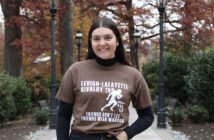Joachim Grenestedt, a professor of mechanic engineering at Lehigh, worked with colleagues to create a new model of a monoski that was used in the Winter X Games and the Olympics.
A monoski is a performance vehicle and is a single board ski attached to both feet. Unlike snowboarding, both feet face forward, as opposed to sideways, to help direct the movements. The original monoski was invented by Dennis Phillips in the 1950s.
Grenestedt, always having a deep affection for performance vehicles, had interest in monoskis for a while. Having always designed and built things, including manned and unmanned vehicles, developing a new monoski was not an unexpected venture. He was really excited to have his model used in the Olympics even though the team did not do as well as they had hoped.
“Athletics have always been an interest of mine, so it’s actually really cool to see my major connect with that,” Michael DiMartino, ’17 and engineering major, said. “It’s also a testament to the interesting work the people here at Lehigh are doing.”
When former Lehigh student, Brian Kaplun, ’06, broke his back in a mountain biking incident, Grenestedt contacted him and got him interested in trying monoskiing. Grenestedt worked with Kaplun and was with him during the his first attempt at skiing. The program that the student was involved in had a number of monoskis already, but many were broken.
“I believed a better and sturdier monoski could be designed and built,” Grenestedt said. “I looked at it as a fun engineering challenge.”
The first model was inspired from existing models combined with various ideas on how to improve the monoski’s performance. Grenestedt worked alongside Lehigh mechanical technician Bill Maroun to design their new prototype.
Grenestedt said they designed the monoski similar to how vehicles are designed, so they placed major emphasis on things such as shock and spring performance, suspension kinematics, good bearings, and the strength and stiffness of the components.
The idea to build this monoski was around for a while, but unsuccessful attempts at fundraising prevented them from carrying out the idea. Eventually, they built it regardless of the financial situation. Grenedest said Maroun should receive the most credit for producing the first prototype.
A few years later, Grenestedt’s wife, Channy Tokura, started a company called DynAccess to develop and sell a new model. That company currently has three commercial models – Tensor, Torque 1 and Torque 2 – and a large number of research models.
“Like professor Joachim, I really like performance vehicles,” Colton Marko, ’17, said. “This is a prime example of what I, and I’m sure many other engineers also want our careers to look like – to find something we love and work with it to make it better.”
Currently, Grenestedt is working on more research surrounding vehicles.
“My Lehigh research uses a number of vehicles designed and built in my labs, including the manned high-speed offshore boat ‘Numerette,’ the ‘JetStreamer’ high-altitude unmanned aircraft, 10 ‘LORCA’ unmanned boats, etc.,” he said.





Comment policy
Comments posted to The Brown and White website are reviewed by a moderator before being approved. Incendiary speech or harassing language, including comments targeted at individuals, may be deemed unacceptable and not published. Spam and other soliciting will also be declined.
The Brown and White also reserves the right to not publish entirely anonymous comments.